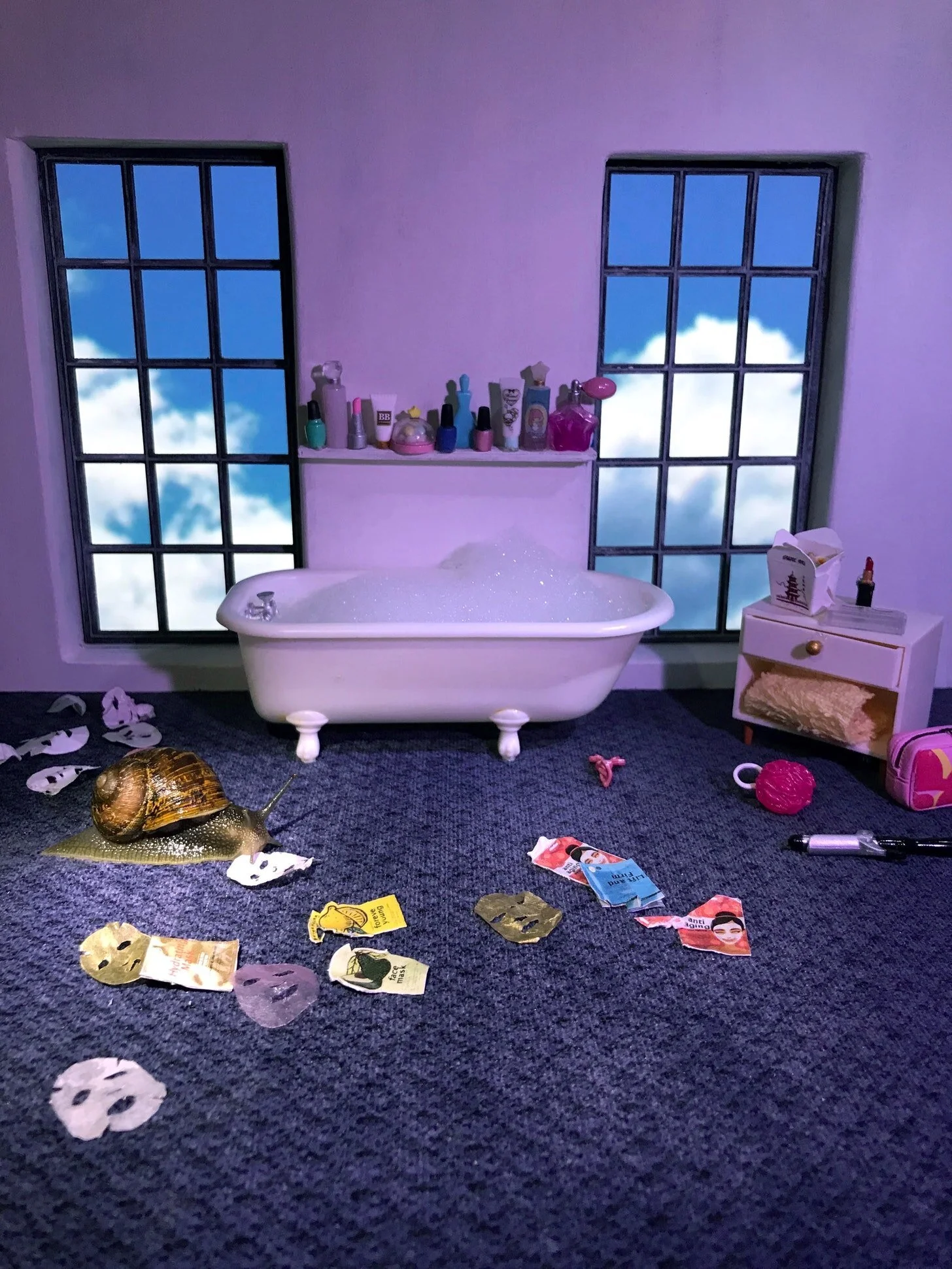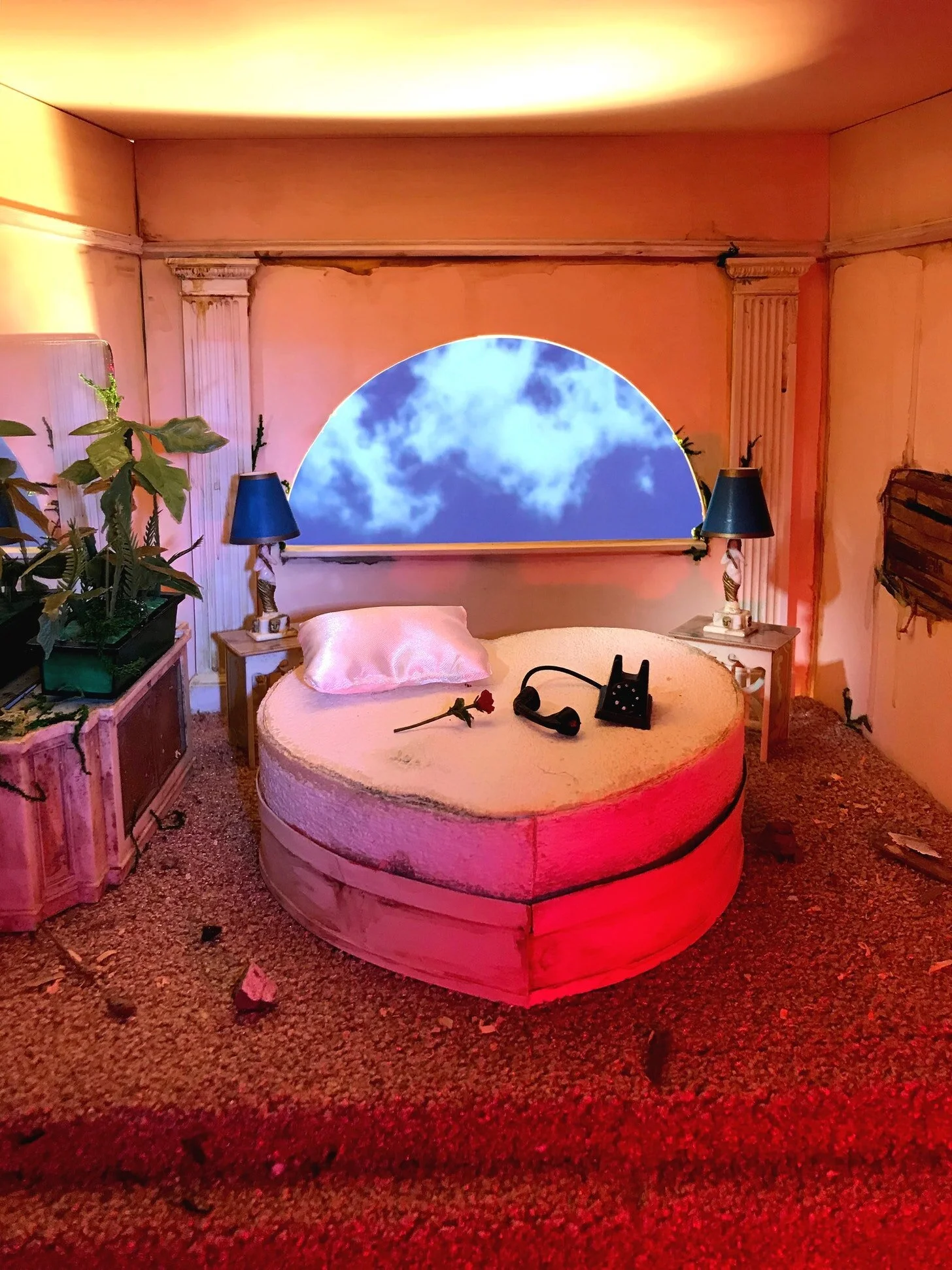Coming Out Of Their Grave... & Aleia's Snails Are Doing Just Fine
Make it stand out
Snails as artistic muses don’t necessarily scream romance — but in Aleia Murawski’s hands, snails, frogs and guinea pigs all become the great romantic leads you never knew you needed. Together with artist Samuel Copeland, she transforms her slimy subjects into hunky coastguards, Vegas gamblers, or mourners gathering around a hearse. Having created work for SSENSE, Apple and Nike, both Murawski’s personal and commercial work combine her singular vision with genuine heart.
Using miniatures that she finds on walks around her hometown of Chicago, Murawski creates luscious miniature sets that luxuriate in bright colours and soft lighting. Hers is a world where anything can happen: where houses fly, snails get married and macaroni cheese makes for a relaxing bath. These vignettes are surprisingly human, strikingly tender. In her Instagram captions Murawski is very open about how she and Copeland create the special effects that they use, but the magic extends beyond fake blood and green screens. By replacing humans with snails and other creepy crawlies, Murawski forces us to pause and consider her portraits with new eyes, and a refreshed sense of empathy for ourselves and those around us.
For our special Valentine’s day issue, Aleia created an exclusive photo series for us featuring her gorgeous snails. She chatted to us below about how she sets up her shots, why death and loss is an integral part of love, and what we can learn from her snail scenes.
How did you start making miniature scenes for snails and frogs?
Sam found our snails around the same time that we started making and collecting miniatures — we were immediately captivated by them. We realised our sets and miniatures were roughly snail-sized. We started putting them into the pieces and were amazed by how they interacted with their environments and how they activated each scene. Froggo is a newer addition; he makes special cameos from time to time. Since he’s larger than the snails, he’s great for scenes that are a little bigger in scale.
What is it about the miniature that draws you in in terms of exploring intimacy?
It’s more about exploring my inner world than relationships, I think. I work by observing what’s around me, and also attempting to understand my interior world as well. I try and keep my work pretty intuitive and let ideas arise or connections form as I go. The hardest part is committing to the unknown process of starting a new project, trusting the decisions I make and remembering that things don’t come together instantly.
Your work conveys a tenderness even though it's often of animals that are typically thought of as slimy or gross. Why is this important to you?
Making snails the subject adds humour to the work and invites people in. Regardless of how you view snails, I think it’s hard to look at a snail sitting alone at a table with a miniature newspaper and coffee and not wonder about it for a moment. Snails occupying these little worlds, living their private lives, it just slows us down a bit and asks people to contemplate these scenes and notice little details tucked away in the background. It allows people to draw comparisons to their own lives. There’s a huge aspect of play in what we do, about imagining other worlds or narratives, and that’s extended to anyone who looks in. I really love that.
How do you set up your shots to create intimacy?
So much of this is in the lighting. We use flashlights with little gels and can spend hours trying to light a scene — that’s usually how we communicate a certain mood or feeling. That’s as well as filming so closely into the miniature sets, bringing the viewer intimately into the frame, creating the illusion that you are inside this space with the snails.
How do you see death and grief as fitting into intimacy and love?
I try and see it as a mixed bag; they’re not separate and often one informs the other. Love can encompass grief. Grief can surround death, or be about a relationship that came and went. Loss can be about something we never got to experience. You may mourn someone who is alive, living in proximity to you. I’m trying to learn and accept the nuances where these emotions overlap while working to not minimise the feelings I don’t like or want to feel: to use loss or grief or death as a way of understanding and appreciating the present.
Why do you think we find it difficult to accept death and loss as part of the spectrum of love?
I know I’m not alone in trying to minimise or numb emotions I don’t like having, or discomforts I don’t want to experience. We want pleasurable feelings and comfort. However, I’ve been learning the hard way what it’s like to close off from a feeling and have it come back with different heads and faces later on. It’s hard to do this internal kind of work, to experience pain or discomfort as it arises. It’s been helpful for me to recognise that, while these feelings can be complicated, it always shifts and changes too.
By substituting humans for snails in difficult acts like standing by a grave and mourning, what message do you hope to convey?
Sometimes it’s easier to see ourselves or work through a situation when we’re not directly in it. It being about a snail gives us a little distance. Sometimes we need that.
Which artists do you think best create intimacy in their work, either in depicting love or grief?
The first thing to come to mind is the last book I read that my friend Grace Miceli recommended: In the Dream House by Carmen Maria Machado. She writes about suffering and destructiveness of an intimate relationship, one that was once based in love and desire. It broke me to bits in haunting and complicated ways that was weirdly comforting to me.
What have you got coming up that you're excited about?
Sam and I really want to work on a long-form video with the snails. Everything we have been making exists as an image or a short video, and we’d love to develop a longer, more melancholic and detailed story.
Words: Jemima Skala | Photos: Aleia Murawski



